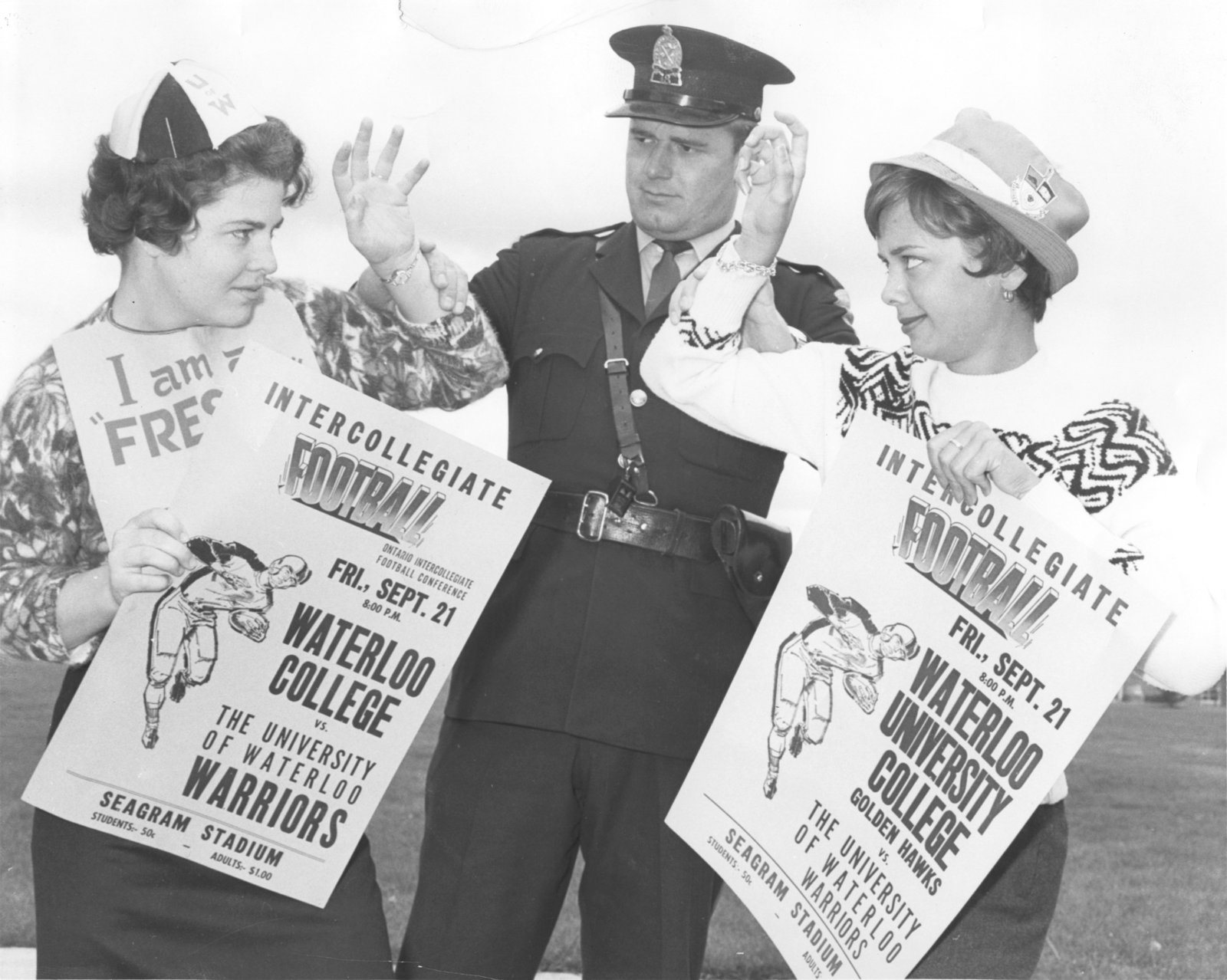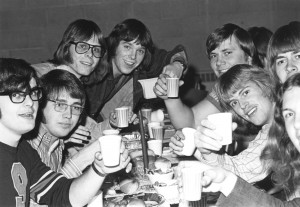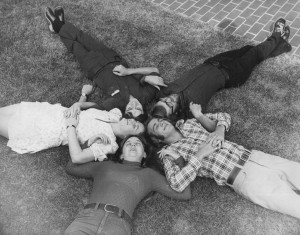Laurier Golden Years: Part 2


The 1960s
Waterloo Lutheran University was the place where Shinerama actually involved shining shoes and the library was a building with only two floors. In fact, much of the university’s infrastructure was not yet present during that time. However, some of its current professors were.
Academics
“Don Morgenson was around,” recalled alumni student David Oates who studied psychology at Waterloo Lutheran, the final precursor to Wilfrid Laurier University, during the late 1960s.
“The very first lecture, it was in Psychology 101 in the lecture hall there, and at that time people could smoke during classes and in the rooms,” he continued. “[Moregnson] would come in with these great, huge pipes. One time he lit up his pipe and smoke was all around him and you couldn’t even see his face and he just waved the smoke around and said, ‘I’m still here.’ I still remember that.”
The work conducted for these classes, however, was a much different affair.
“Research was very labourious because we had to write things out. We had to be very careful putting the commas and periods in for citations and doing it properly,” said Oates. “The professors were very stingy about that.”
Although this was taxing, Oates only spent half of his time studying in the more academic locations on campus that such work required. The other half was spent in the Torque Room, which we now refer to simply as the Concourse.

On Campus
“The library was the place where you did research and found stuff and wrote things out. The Torque Room was where you drank coffee and had fun,” said Oates.
“We drank one heck of a lot of coffee, let me tell you,” he continued. “But we did a lot of work as well because a lot of us took the same kind of courses.”
Although this was true of the majority of the student population at Waterloo Lutheran, the first ‘WLU,’ was primarily an arts school.
“I was one of the fifth table Torque Room boys. We were the fifth table from the door. We chose that because we were halfway between where the football players and basketball players met and all of the other artsies on the other side,” Oates explained about his particular group of university friends. “We wanted to be like the jocks, but we weren’t. And we wanted to be like the arts people and we weren’t so we were in the middle.”
This isn’t to suggest there was a higher degree of exclusivity during that decade than what exists now, actually Oates would argue the opposite.
“The Torque Room ethic is gone, you don’t seem to have the same kind of camaraderie and connectedness to the university that the Torque Room symbolized, for me anyways,” he said.
The students of Waterloo Lutheran were also more involved in the university’s athletic atmosphere, which wasn’t difficult considering the central location of everything on its significantly smaller campus.

Athletics
“[The Torque Room] was a great spot because you could look over to see the football field. Where alumni field is now, they used that for football,” said Oates.
“We had a riot at the football games. The fifth table Torque Room boys followed the basketball team around the year they won the [national] championship [1967-68] … all their games around the province,” he continued. “It was crazy, we rented cars and borrowed cars and took trains and buses and stuff to get to these places.”
These were some of Oates’ fondest memories as a university student.
“Being there with a whole bunch of people that were watching the game, freezing our buns off, drinking beer illegally and just being there to cheer on a bunch of people who were doing some good things,” he reminisced. “At basketball we couldn’t drink in the stands, but of course we drank afterwards.”
Of course, there weren’t too many opportunities for drinking within the university atmosphere at that time other than the odd smuggled beer to such events. This was before the Turret or Wilf’s opened, which meant that general entertainment was limited as well. However the school would did in musical talent for special occasions.
“I often wondered and marvelled how such a small school could get people like Chuck Berry and The Supremes for winter carnival,” said Oates. “My wife and I, our first date was to The Supremes at winter carnival.”
So sports it was, which, along with traditions like the winter carnival, first fuelled the remarkable school spirit that still burns brightly in Laurier students today.
“It was that team spirit and that whole thing about cheering for your team no matter how good they were,” Oates recalled. “I remember the cheerleaders, how enthusiastic they were even when the team was losing.”

Generational Culture
This decade saw the emergence of many progressive attitudes, not merely confined to a university setting.
“The social movements were very important,” states Oates.
“I think a big movement too was more personal and social interactive processes, more understanding process where people understood what people were saying and doing through dialogue. People were sitting down and talking with people and I think that was something that wasn’t happening before.
“Campus was always a venue for discussion and academic argument and philosophical discussions. I think it was more than that too.”
Students and people in general were not only addressing what existed, they were questioning how it could evolve.
“How do we get around this problem of drugs, how do we get around the problem of racial discrimination, how do we integrate different groups of people into our milieu?” illustrated Oates.
It’s important to note that this was a time when the student population was primarily male.
“It was all guys … more guys then there were women. That certainly has changed, there are more ladies on campus then there are men now,” said Oates.
“There was still that lagging ‘50s ethic where the lady married and stayed home and raised children and didn’t go out to work or any of that stuff and didn’t go past anything than high school,” he explained.
“That would be one of the changes, an equality of academic freedom … that change was developing through the late ‘60s.”
A lot of the justified normalities of today can be traced back to this time period, which Oates feels grateful to have been a part of.
“That was one thing that came out of all of that, that social revolution that we were a part of. The problem is that when you’re in the middle of it you don’t realize how important it is that it’s happening until you look back.”
The 1970s
The transition of Waterloo Lutheran University to Wilfrid Laurier University during this decade meant a lot of changes for the school, such as the renaming of several residences and the opening of a liquor-licenced establishment on campus. These changes largely came because after receiving provincial funding, the university was no longer a private religious school, as it had been since its inception in 1911. There were some lingering customs however, and the students were grateful for them.

On Campus
“We used to have a break between 10 a.m. and 10:30 a.m. and basically it was like recess. In other words, no classes. So everybody used to go for coffee at that time,” recalled Laurier alumnus Steve Wilkie who studied business administration at the university during the late 1970s.
“It had been cut from an hour because prior to that, between 10 a.m. and 11 a.m., you were supposed to have a spiritual hour, whether you went to the chapel or not.”
A few other remaining enforcements however were not as appraised, particularly in regards to residence.
“Guys were only allowed overnight on Friday and Saturday. Monday to Thursday you were out by 11 p.m.,” said Wilkie of the all-female residence Conrad Hall. “We called it Clara Convent. You used to have to keep the door open.”
Wilkie did not experience residence living during his time as a student at Laurier due to its much smaller size.
“When I was in first year there was no such thing as residence for all first year students so I lived off campus,” he said.
However, there were other means by which he was able to get involved on campus.
“One off the biggest groups at that time was called Offcam which did a lot of activities for off campus students to try and integrate them into the student life experience.”

Academics
Along with the classrooms they filled, the student populous was also significantly smaller which made the academic atmosphere slightly different. Especially in upper years, as it is today, small classes then coupled with campus sizes meant a different degree of commitment for the students.
“You miss one of those classes, you were noticed. If [the prof] saw you the rest of the day you would have had to be walking with a limp or have a note,” joked Wilkie.
If you made it to class however, much of what went on within its curriculum was the same.
“You had a midterm, you had a final and you had a paper. It’s just that you did a lot of research in the library, you wrote long hand and you had typists,” said Wilkie.
“We had off-campus ladies who were very competent in typing using typewriters … they made a killing,” he continued. “They used to put ads up all over campus and you used to just call someone.”
Since typewriters were only really required for bigger assignments, many people didn’t have one. This was especially true for the male population which made up the majority of Laurier students.
“When you go back, even when I was in high school in the 1970s, typing or keyboarding was for girls. Guys didn’t do it,” said Wilkie. “Nowadays I regret every time I didn’t take it, but it was all female courses.”

Night Life
The male majority at Laurier however did require there be some activities on campus, some less academic, that were geared in their direction.
“Monday night was big, it was Monday Night Football up at the Turret,” said Wilkie.
“Guys with beers.”
Most leisure activities occurred at the school, but there wasn’t the same kind of weekend activity that there is now.
“I never strayed off campus,” Wilkie stated. “The Turret was the place to go, Thursday night was the big night. A lot of kids tended to go home Fridays.
“Thirty years ago there wasn’t the development that you have nowadays with Morty’s and all that.”

Change and Similarity
Even with all the time spent on university grounds, there wasn’t the same relationship between the school and the students as there is now, according to Wilkie.
“What I see right now from where we were to where you are today is really an evolution for students of becoming more of a partner of the university in the sense that the university has become more transparent,” he said.
“It used to be very much the ivory tower; it used to be very impenetrable, now universities are more accessible.”
This is true now right from the student’s first interaction with their school, when they are going through the application selection process.
“There wasn’t as much benchmarking going on. MacLean’s hadn’t come out [with university rankings],” Wilkie continued.
“For the student now, they have a lot more information to make a good choice as to where they want to go to university. The flip around is that there’s far more competitiveness.”
There was a degree of accessibility at Laurier, however, that still separates it from rival universities and that is the concentrated learning environment.
“Over the years talking with all the different folks, whether it’s a ‘60s grad, ‘80s or ‘90s or 2000s grad, they all talk about the student life experience and the small, intimacy of the campus. What I think is a key to success is that we’ve really kept the teaching all in that centre,” said Wilkie.
“The non-teaching services are moved off campus,” he continued. “So I think that’s what certainly makes the student life experience for today’s kids as great of a success as it was years ago.”


